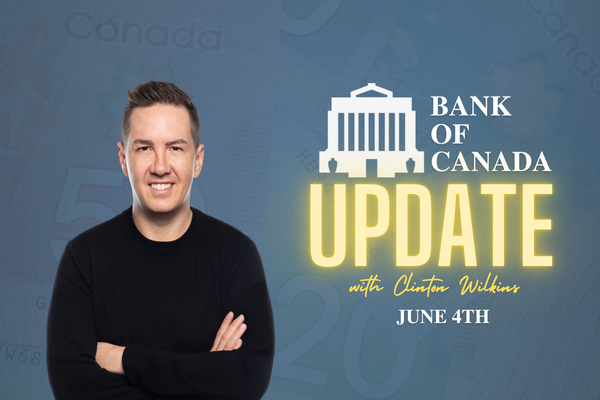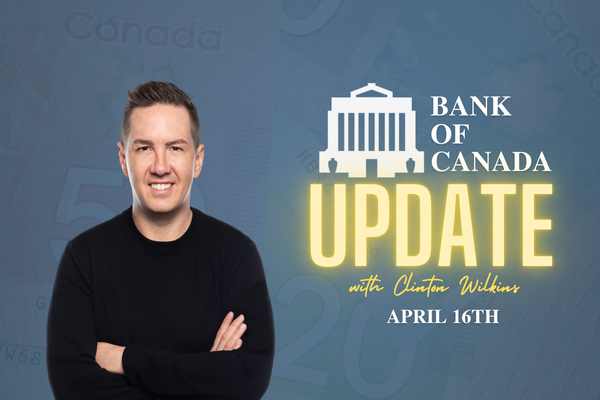On 95.7 News Radio, Clinton and Todd discussed the importance of credit monitoring due to rising fraud and data breaches.

Bank of Canada – Rate Held for The Sake of Stability – June 4th
Clinton Wilkins joins Todd Veinotte on 95.7 News Radio to discuss The Bank of Canada holding its key policy rate at 2.75%, marking the second pause after consecutive cuts.
Todd Veinotte
All right, we will be taking your calls in a little bit, and before that, though, we will be talking to Clinton Wilkins about the Bank of Canada holding its benchmark into rate steady at 2.7% today, as policymakers wait for more clarity. I know tariffs will impact the economy. Clinton Wilkins, our mortgage guru, welcome to the show. As always, my friend.
Clinton Wilkins
Thanks for having me. Todd, really a lot of uncertainty out there right now.
Economic Uncertainty
Todd Veinotte
Uncertainty seems to be the key word right here. And Tiff Macklem talked about uncertainty remaining high around the trade conflict with the United States, and described why that’s such a factor here with us.
Clinton Wilkins
Well, it impacts what’s going on here in Canada. You know, as as much as we have our ecosystem and economy here, really what’s happening is so tied to what’s going on in the US, although their economy is very different from ours, certainly there are many ties, and it does impact what’s happening here at home, and what’s happening obviously, with these rate decisions here for the Bank of Canada.
Todd Veinotte
Okay, so I guess no changes is not a drop, but it’s not an increase as well. So, how do you think that mortgage holders would welcome this news or not?
Mortgage Rate Landscape
Clinton Wilkins
I think stability is okay. Todd, I think a lot of people were optimistic that we’re going to have a rate cut from the bank again, or, sorry, the Bank of Montreal, for example. They put out an article, and they believe that. I think it’s 75 basis points, they’re going to see rate cuts between now and the end of the year. Now, the Bank of Nova Scotia did come out and said they’re not sure they’re going to see any more cuts before the end of the year, but they think there’s going to be more cuts in 2026, so I think the consensus is we’re going to see rates be lower. The question is, when will we see them be lower? And I think that’s the real question right now. I’m okay with stability. Consumers can plan, they can budget, and they can know what their cost of borrowing is right now. And that being said, Todd, fixed rates are a completely different environment right now. We’ve really seen an uptick in fixed rates. You know, we were very, you know, optimistic, and we’re seeing some rates, starting with a three here, even just a few weeks ago. But we certainly have seen some increase in the fixed rates just due to what’s going on in the bond market and the cost of funds.
Todd Veinotte
We’re fixed rates generally right now. I know would vary depending on people’s financial situation with the lender. But generally, where are they sitting?
Clinton Wilkins
Most fixed rates are in the low to mid fours right now, Todd, depending on which term a consumer we’re going to take, and if it’s a refinance versus a purchase, versus a purchase with high ratio insurance from the Canadian Mortgage Housing Corporation, Sage and our Canada guarantee. So the rate product certainly is impacting the rate that a consumer is going to get. So the product is very, very important, and not a one-size-fits-all right, right now. Todd, so I think that’s important to understand. I think at renewal, consumers are seeing maybe a rate that is as much as 25 basis points less than a consumer would get on a refinance file, for example.
Todd Veinotte
Okay, so we remember historical lows not all that long ago. I don’t anticipate, or do you anticipate, that we’ll we’ll see anything nearly what we saw in the early 2020s.
Consumer Financial Protection
Clinton Wilkins
These are very uncertain. I think if the economy does end up crashing, I think we will see rates again, maybe at that 2020 level. I think what we need to remember right now, Todd, is that those rates likely went too low, and that’s why we had the increases over the last 18 and 24 months that then people had to deal with, obviously, a higher cost of borrowing. We had to bring inflation down. So I don’t know if we’ll go as low as you know, we saw in 2020, but I do think we’re going to go lower than where they are right now, but I’m kind of okay with where the rates are. Yeah, we’d love to have rates that are in the threes, but at least we can plan. And I think where the rates are right now is that it’s not inflationary, but it’s also not suppressive, either. So right now we’re in more of a balanced rate environment, and I think the longer the rates stay stable, I think the people can plan, they can make decisions. And I think anyone who’s looking for that kind of longer-term borrowing now is a good time as any to get a rate. You know, if you can use a rate at 4% sure, it’s not 2%, but it’s also not 6%, so I think that’s the one thing that we need to remember. We’re more in that median mark right now, and hopefully.
Todd Veinotte
People learn their lessons from from when they were historically low, to not get over to not overspend on your mortgage leverage, right? It’s and we know the stress test is built in there, but, but a lot of people were caught off guard when rates didn’t increase and their mortgage renewed at the end of that, and I hopefully people will learn that lesson. Do you have that conversation with your cut, with your clients?
Clinton Wilkins
Thank goodness for the stress test, Todd. I know people were cursing it, you know, they weren’t maybe affording what they would have afforded, you know, previously. But thank goodness for the stress test, because it protected Canadians from themselves. You know, for us, when we’re doing a qualification, we look at what people can afford and what people can get approved for. And sometimes those are very different numbers, and I think that’s where you need to have a look in the mirror before you start looking out the window, on really what your financial goals are. And that’s why mortgage lending is so complex, and that’s why it’s so important that consumers need to trust a professional and stick with them. You know, we are not a one-and-done operation. It’s really about building that relationship. And for us, yes, the rate is important, but it’s not the be-all and end-all. And the lowest rate isn’t always the best rate, because there’s a wide range right now in terms of products, and I think some consumers are certainly feeling that now, especially when their mortgages are coming up for renewal.
Market Dynamics
Todd Veinotte
Indeed. So when it comes to rates, I guess some stability is not a bad thing. That’s kind of your key message here, right?
Clinton Wilkins
That is certainly the key message. It’s very busy right now. And I think the amount of volume in terms of mortgage lending, the event, amount of volume in terms of real estate sales, is high, and the rates are not slowing people down. So I think a lot of people were standing on the sidelines the last two years, rates in the 6% range that slowed people down. But now we’re getting into a situation where it’s more balanced and there is some pent-up demand. So people are doing transactions. And I would say right now, based on what I’m hearing and what I’m seeing, it’s a great time to do mortgage financing. It’s a great time to buy real estate. The demand is still high, but we are getting some more supply coming on hand in Halifax, and we need much more supply, so I hope that we’ll see more here very soon. Okay, Clinton,
Todd Veinotte
Always great, my friend. Thanks so much, and we’ll talk again soon. Clinton Wilkins, our mortgage guru.


